Spatial Pattern of the Vitality of Chinese Characteristic Towns: A Perspective from Nighttime Lights
Abstract
:1. Introduction
2. Materials and Methods
2.1. Study Area
2.2. Data Sources
2.3. Methods
2.3.1. DN Value Calculation
2.3.2. Natural Interruption Point Grading Method
2.3.3. Global Moran’s I Tool
2.3.4. Anselin Local Moran’s I
3. Results
3.1. Current Situation of Town Vitality
3.2. Spatial Distribution Characteristics
3.2.1. Overall Spatial Pattern
3.2.2. Local Spatial Pattern
3.3. Spatial Analysis of the Vitality of Chinese Characteristic Towns
3.3.1. Global Spatial Autocorrelation Analysis
3.3.2. Local Space Autocorrelation Analysis
3.4. Analysis of the Drivers of High-Vitality Towns
4. Discussion
4.1. Night Lighting Data Perspective of Town Vitality
4.2. Limitations
5. Conclusions
Author Contributions
Funding
Institutional Review Board Statement
Informed Consent Statement
Data Availability Statement
Acknowledgments
Conflicts of Interest
References
- He, B.; Zhao, D.; Xiong, K.; Qi, J.; Ulpiani, G.; Pignatta, G.; Prasad, D.; Jones, P. A framework for addressing urban heat challenges and associated adaptive behavior by the public and the issue of willingness to pay for heat resilient infrastructure in Chongqing, China. Sustain. Cities Soc. 2021, 75, 103361. [Google Scholar] [CrossRef]
- Huang, C.; Wu, W.; Hu, X. Development Paths of Characteristic Towns in Underdeveloped Areas in Central China-A Case Study of Yichun, Jiangxi. Asian Agric. Res. 2018, 10, 30–32. [Google Scholar] [CrossRef]
- Wu, Y.; Chen, Y.; Deng, X.; Hui, E.C.M. Development of characteristic towns in China. Habitat Int. 2018, 77, 21–31. [Google Scholar] [CrossRef]
- Bowen, C.; Zhenwei, P. Connotation and Path of Characteristic Development of Small Towns under Supply-Side Reform:Cases of the First Batch of Chinese Characteristic Small Towns in Yangtze River Delta Region. Urban Plan. Forum. 2018, 73–82. [Google Scholar] [CrossRef]
- Fu, X.; Jiang, Y. Discussion on the Development Model of Characteristic Towns in China from the Perspective of Embeddedness. China Soft Sci. 2017, 8, 102–111. [Google Scholar]
- Jifu, Z. The path and mode of charismatic small town construction--Take Datong city of Shanxi province for example. Chin. J. Agric. Resour. Reg. Plan. 2017, 38, 145–151. [Google Scholar] [CrossRef]
- Luo Xiang, S.J. Thoughts and Measures for Characteristic Town Planning From Supply-side Structural Reform Viewpoint. Planners 2017, 33, 38–43. [Google Scholar]
- Wang Boya, Z.C.C.Y. Reconsiderationon the Positioning and Function of Characteristic Towns: An important carrier for the integrated development of urbanand rural areas. J. Beijing Norm. Univ. (Soc. Sci.) 2020, 140–147. Available online: https://kns.cnki.net/kcms/detail/detail.aspx?dbcode=CJFD&dbname=CJFDLAST2020&filename=BJSF202001012&uniplatform=NZKPT&v=mHHseh397NWbN7OLu9vhd_imqZePAYSWb4EnQBAb6SqZM_lttlnDeemPZP4kpPKu (accessed on 6 December 2021).
- Dongmei, L.; Linfeng, Z.; Sainan, L.; Xi, Y.; Shemei, Z.; Fang, W. Study on the Formation Mechanism and Path Optimization of Agricultural Characteristic Towns—Case Analysis Based on Chengdu Model. China Soft Sci. 2018, 79–90. Available online: https://kns.cnki.net/kcms/detail/detail.aspx?dbcode=CJFD&dbname=CJFDLAST2018&filename=ZGRK201805008&uniplatform=NZKPT&v=XbsIuo4Cje9ZqeuEBFoF5y3vk1gp_B-oXaao2So8Ia9zQoeJcVStH0688nM0xI1l (accessed on 6 December 2021).
- Yizhou, W.; Qianhu, C.; Xiaohong, Z. Indices System and Evaluation Method of Characteristic Town Development. Planners 2016, 32, 123–127. [Google Scholar] [CrossRef]
- Chengxin, W. Research on Cultural Development of Characteristic Towns in China. World J. Soc. Sci. Res. 2017, 4, 237–242. [Google Scholar] [CrossRef] [Green Version]
- Hua, Z. Analysis on the Innovation and Exploration of the Tourist Characteristic Town. Econ. Probl. 2017, 104–107. [Google Scholar] [CrossRef]
- Li Xinjian, F.L.S.S. The Endogenous Development and Path of Tourism Characteristic Towns. Tour. Trib. 2018, 33, 7–9. [Google Scholar] [CrossRef]
- Fang, H.; Jiancheng, L. A research on features of characteristic towns in Hangzhou. Urban Plan. Forum 2017, 78–84. [Google Scholar] [CrossRef]
- Pei, L.; Jinhe, Z.; Chang, W.; Lin, Z. Classification and Spatial Distribution Features of Characteristic Towns in China. Econ. Geogr. 2020, 40, 52–62. [Google Scholar] [CrossRef]
- Hong, X.; Yinghao, L.; Youyi, W. Influencing Factors and Spatial Distribution of the Characteristic Towns in Zhejiang Province. Sci. Geogr. Sin. 2018, 38, 1283–1291. [Google Scholar] [CrossRef]
- Cao, S.; Li, T.; Gao, H. Research on “Static-Dynamic” Development of Characteristic Towns in China Based on Space and Type: A Big Data Analysis. Am. J. Ind. Bus. Manag. 2019, 9, 1639–1652. [Google Scholar] [CrossRef] [Green Version]
- Haonan, S.; Yang, X. Spatial distribution characteristics of national characteristic towns. J. Arid. Land Resour. Environ. 2019, 33, 39–44. [Google Scholar] [CrossRef]
- Yelin, F.; Zhenfang, H.; Jinglong, L.; Fang, W. Spatial distribution of characteristic towns and their industrial characteristics in China. J. Nat. Resour. 2019, 34, 1273–1284. [Google Scholar] [CrossRef]
- Yin, X.; Wang, J.; Li, Y.; Feng, Z.; Wang, Q. Are small towns really inefficient? A data envelopment analysis of sampled towns in Jiangsu province, China. Land Use Policy 2021, 109, 105590. [Google Scholar] [CrossRef]
- Lynch. Good City Form; MIT Press: Cambridge, MA, USA, 1981. [Google Scholar]
- Difei, J. The Theory of Urban Form Vitality; Southeast University Press: Jiangsu, China, 2007. [Google Scholar]
- Li, L.; Yilun, X.; Shanhu, J.; Qingming, W. Evaluation of urban vitality based on fuzzy matter-element model. Geogr. Geo-Inf. Sci. 2010, 26, 73–77. [Google Scholar]
- Qiong, W. Difference and Factor Analysis of Urban Vitality of 19 National-Level New Areas. Master’s Thesis, South China University of Technology, Guangzhou, China, 2019. [Google Scholar]
- Ying, Z. Research on the Measurement and Influence Mechanism of Urban block Vitality—Taking the Main City of Wuhan as an Example. Master’s Thesis, Wuhan University, Wuhan, China, 2019. [Google Scholar]
- Yujia, M.; Yong, L.; Jiasong, Z. Vitality assessment of mountainous cities based on multi—Source data: A case of Chongqing Municipality, China. Resour. Sci. 2020, 42, 710–722. [Google Scholar] [CrossRef]
- Ta Na, Z.Y.Z.Q. Relationship between built environment and urban vitality in Shanghai downtown area based on big data. Sci. Geogr. Sin. 2020, 40, 60–68. [Google Scholar] [CrossRef]
- Sangzhaxi, L.; Feng, Z. How to evaluate public space vitality based on mobile phone data: An empirical analysis of Nanjing’s parks. Geogr. Res. 2019, 38, 1594–1608. [Google Scholar]
- Fan, D. Quantifying Urban Vitality and Its Growth Strategy Using Spatio-Temporal Big Data. Master’s Thesis, Wuhan University, Wuhan, China, 2019. [Google Scholar]
- Tingting, Z.; Wei, T.; Yang, Y.; Chen, Z.; Tianhong, Z. Sensing urban vibrancy using geo-tagged data. Acta Geod. Cartogr. Sin. 2020, 49, 365–374. [Google Scholar]
- Delclòs-Alió, X.; Miralles-Guasch, C. Looking at Barcelona through Jane Jacobs’s eyes: Mapping the basic conditions for urban vitality in a Mediterranean conurbation. Land Use Policy 2018, 75, 505–517. [Google Scholar] [CrossRef]
- Fuentes, L.; Miralles-Guasch, C.; Truffello, R.; Delclòs-Alió, X.; Flores, M.; Rodríguez, S. Santiago de Chile through the Eyes of Jane Jacobs. Analysis of the Conditions for Urban Vitality in a Latin American Metropolis. Land 2020, 9, 498. [Google Scholar] [CrossRef]
- Delclòs-Alió, X.; Gutiérrez, A.; Miralles-Guasch, C. The urban vitality conditions of Jane Jacobs in Barcelona: Residential and smartphone-based tracking measurements of the built environment in a Mediterranean metropolis. Cities 2019, 86, 220–228. [Google Scholar] [CrossRef]
- Xia, C.; Yeh, A.G.; Zhang, A. Analyzing spatial relationships between urban land use intensity and urban vitality at street block level: A case study of five Chinese megacities. Landsc. Urban Plan. 2020, 193, 103669. [Google Scholar] [CrossRef]
- Ye, Y.; Li, D.; Liu, X. How block density and typology affect urban vitality: An exploratory analysis in Shenzhen, China. Urban Geogr. 2018, 39, 631–652. [Google Scholar] [CrossRef]
- Li, X.; Qian, Y.; Zeng, J.; Wei, X.; Guang, X. The Influence of Strip-City Street Network Structure on Spatial Vitality: Case Studies in Lanzhou, China. Land 2021, 10, 1107. [Google Scholar] [CrossRef]
- Jalaladdini, S.; Oktay, D. Urban Public Spaces and Vitality: A Socio-Spatial Analysis in the Streets of Cypriot Towns. Procedia-Soc. Behav. Sci. 2012, 35, 664–674. [Google Scholar] [CrossRef] [Green Version]
- Yang, J.; Cao, J.; Zhou, Y. Elaborating non-linear associations and synergies of subway access and land uses with urban vitality in Shenzhen. Transp. Res. Part A Policy Pract. 2021, 144, 74–88. [Google Scholar] [CrossRef]
- Xu, Y.; Chen, X. Quantitative analysis of spatial vitality and spatial characteristics of urban underground space (UUS) in metro area. Tunn. Undergr. Space Technol. 2021, 111, 103875. [Google Scholar] [CrossRef]
- Dong, Y.; Peng, F.; Guo, T. Quantitative assessment method on urban vitality of metro-led underground space based on multi-source data: A case study of Shanghai Inner Ring area. Tunn. Undergr. Space Technol. 2021, 116, 104108. [Google Scholar] [CrossRef]
- Niu, Y.; Mi, X.; Wang, Z. Vitality evaluation of the waterfront space in the ancient city of Suzhou. Front. Archit. Res. 2021, 10, 729–740. [Google Scholar] [CrossRef]
- Shi, J.; Miao, W.; Si, H.; Liu, T. Urban Vitality Evaluation and Spatial Correlation Research: A Case Study from Shanghai, China. Land 2021, 10, 1195. [Google Scholar] [CrossRef]
- Yang, Y.; Ma, Y.; Jiao, H. Exploring the Correlation between Block Vitality and Block Environment Based on Multisource Big Data: Taking Wuhan City as an Example. Land 2021, 10, 984. [Google Scholar] [CrossRef]
- Kim, Y. Data-driven approach to characterize urban vitality: How spatiotemporal context dynamically defines Seoul’s nighttime. Int. J. Geogr. Inf. Sci. IJGIS 2020, 34, 34–1235. [Google Scholar] [CrossRef]
- Jin, X.; Long, Y.; Sun, W.; Lu, Y.; Yang, X.; Tang, J. Evaluating cities’ vitality and identifying ghost cities in China with emerging geographical data. Cities 2017, 63, 98–109. [Google Scholar] [CrossRef]
- He, Q.; He, W.; Song, Y.; Wu, J.; Yin, C.; Mou, Y. The impact of urban growth patterns on urban vitality in newly built-up areas based on an association rules analysis using geographical ‘big data’. Land Use Policy 2018, 78, 726–738. [Google Scholar] [CrossRef]
- Kim, Y. Seoul’s Wi-Fi hotspots: Wi-Fi access points as an indicator of urban vitality. Comput. Environ. Urban Syst. 2018, 72, 13–24. [Google Scholar] [CrossRef]
- Yue, W.; Chen, Y.; Thy, P.T.M.; Fan, P.; Liu, Y.; Zhang, W. Identifying urban vitality in metropolitan areas of developing countries from a comparative perspective: Ho Chi Minh City versus Shanghai. Sustain. Cities Soc. 2021, 65, 102609. [Google Scholar] [CrossRef]
- Zeng, C.; Song, Y.; He, Q.; Shen, F. Spatially explicit assessment on urban vitality: Case studies in Chicago and Wuhan. Sustain. Cities Soc. 2018, 40, 296–306. [Google Scholar] [CrossRef]
- Lan, F.; Gong, X.; Da, H.; Wen, H. How do population inflow and social infrastructure affect urban vitality? Evidence from 35 large- and medium-sized cities in China. Cities 2020, 100, 102454. [Google Scholar] [CrossRef]
- Poot, J.; Pawar, S. Is Demography Destiny? Urban Population Change and Economic Vitality of Future Cities. J. Urban Manag. 2013, 2, 5–23. [Google Scholar] [CrossRef]
- Mouratidis, K.; Poortinga, W. Built environment, urban vitality and social cohesion: Do vibrant neighborhoods foster strong communities? Landsc. Urban Plan. 2020, 204, 103951. [Google Scholar] [CrossRef]
- Montgomery, J. Editorial Urban Vitality and the Culture of Cities. Plan. Pract. Res. 1995, 10, 101–110. [Google Scholar] [CrossRef]
- Mengqi, Z. Analysis and Evaluation of Urban Vitality. Master’s Thesis, Wuhan University, Wuhan, China, 2018. [Google Scholar]
- Shuiling, L. Research on Evaluation and Influencing Factors Analysis of Urban Vitality in Wuhan Metropolitan Area. Master’s Thesis, Wuhan University, Wuhan, China, 2020. [Google Scholar]
- Wang Na, W.J.L.S. Spatial Features of Urban Vitality and the Impact of Built Environment on Them Based on Multi-Source Data: A Case Study of Shenzhen. Trop. Geogr. 2021, 41, 1280–1291. [Google Scholar] [CrossRef]
- Quanyi, L.; Qingming, Z.; Jiansong, L.; Chen, Y.; Wen, L. Extracting Built-up Areas Using Luojia-1A Nighttime Light Imageries in Wuhan, China. Geomat. Inf. Sci. Wuhan Univ. 2021, 46, 30–39. [Google Scholar] [CrossRef]
- Xiang, L.; Jiang, Z.; Xiangdong, Y.; Jiangchun, Y.; Huang, C.; Mitao, L. Mapping construction land of Guangzhou based on Luojia No.1 nightlight data. J. Geo-Inf. Sci. 2019, 21, 1802–1810. [Google Scholar] [CrossRef]
- Chang, S.; Wang, J.; Zhang, F.; Niu, L.; Wang, Y. A study of the impacts of urban expansion on vegetation primary productivity levels in the Jing-Jin-Ji region, based on nighttime light data. J. Clean Prod. 2020, 263, 121490. [Google Scholar] [CrossRef]
- Yin, Z.; Li, X.; Tong, F.; Li, Z.; Jendryke, M. Mapping urban expansion using night-time light images from Luojia1-01 and International Space Station. Int. J. Remote Sens. 2020, 41, 2603–2623. [Google Scholar] [CrossRef]
- Qianxiang, L.; Han, Z.; Guo, Z.; Xueyao, G.; Weiling, L. Analysis of Luojia1-01 Index Based on Nighttime Light Imagery. J. Geomat. 2020, 45, 8–15. [Google Scholar] [CrossRef]
- Hang, G. High-Resolution Population Spatialization Based on Multi-Source Data and Random Forests Model—A Case Study in Changsha. Master’s Thesis, Hunan Normal University, Changsha, China, 2020. [Google Scholar]
- Dong, Z.; Deping, L.; Liang, Z.; Man, G.; Hang, G. High precision space estimation of housing vacancy rate using high resolution image and Luojia-1. Bull. Surv. Mapp. 2021, 41–46. [Google Scholar] [CrossRef]
- Shi, L.; Wurm, M.; Huang, X.; Zhong, T.; Leichtle, T.; Taubenböck, H. Urbanization that hides in the dark—Spotting China’s “ghost neighborhoods” from space. Landsc. Urban Plan. 2020, 200, 103822. [Google Scholar] [CrossRef]
- Yang, J.; Wang, Y.; Xiu, C.; Xiao, X.; Xia, J.; Jin, C. Optimizing local climate zones to mitigate urban heat island effect in human settlements. J. Clean. Prod. 2020, 275, 123767. [Google Scholar] [CrossRef]
- Wang, C.; Chen, Z.; Yang, C.; Li, Q.; Wu, Q.; Wu, J.; Zhang, G.; Yu, B. Analyzing parcel-level relationships between Luojia 1-01 nighttime light intensity and artificial surface features across Shanghai, China: A comparison with NPP-VIIRS data. Int. J. Appl. Earth Obs. 2020, 85, 101989. [Google Scholar] [CrossRef]
- Ou, J.; Liu, X.; Liu, P.; Liu, X. Evaluation of Luojia 1-01 nighttime light imagery for impervious surface detection: A comparison with NPP-VIIRS nighttime light data. Int. J. Appl. Earth Obs. 2019, 81, 1–12. [Google Scholar] [CrossRef]
- Zhang Yuxin, L.X.S.Y. Urban Spatial Form Analysis of GBA Based on “LJ1-01”Nighttime Light Remote Sensing Images. J. Appl. Sci. 2020, 38, 466–477. [Google Scholar] [CrossRef]
- Xueling Zhang, T.W. Study on the spatial differentiation pattern of China’s provincial digital economy development. World Surv. Res. 2019, 34–40. [Google Scholar] [CrossRef]
- Goodchild, M.F. What Problem? Spatial Autocorrelation and Geographic Information Science. Geogr. Anal. 2009, 4, 411–417. [Google Scholar] [CrossRef] [Green Version]
- Ord, A.G.A.J. The Analysis of Spatial Association by Use of Distance Statistics. Geogr. Anal. 1992, 24, 189–206. [Google Scholar] [CrossRef]
- Zhi, S.C.; Xiaolu, Y.; Jingqiu, Z. Evaluation of the landscape patterns vulnerability and analysis of spatial correlation patterns in the lower reaches of Liaohe River Plain. Acta Ecol. Sin. 2014, 34, 247–257. [Google Scholar] [CrossRef]
- Shenglan, W.; Ding, L.; Ye, X.; Qiang, C.; Xiaorong, J. Fuzzy comprehensive evaluation on the urban vitality—A case of the main cities in Hubei Province. J. Cent. China Norm. Univ. (Nat. Sci.) 2013, 47, 440–445. [Google Scholar] [CrossRef]
- YanJie, J. Study on Urban Economic Vatality Index in China. Sci. Geogr. Sin. 2007, 27, 9–16. [Google Scholar] [CrossRef]
- Mingyang, L. The Construction and Evaluation for the City Vigor Index System. Master’s Thesis, Dongbei University of Finance and Economics, Dalian, China, 2011. [Google Scholar]
- Feng, Z.; Peng, J.; Wu, J. Using DMSP/OLS nighttime light data and K–means method to identify urban–rural fringe of megacities. Habitat Int. 2020, 103, 102227. [Google Scholar] [CrossRef]
- Xin, X.; Liu, B.; Di, K.; Zhu, Z.; Zhao, Z.; Liu, J.; Yue, Z.; Zhang, G. Monitoring urban expansion using time series of night-time light data: A case study in Wuhan, China. Int. J. Remote Sens. 2017, 38, 6110–6128. [Google Scholar] [CrossRef]
- Zheng, Y.; He, Y.; Zhou, Q.; Wang, H. Quantitative Evaluation of Urban Expansion using NPP-VIIRS Nighttime Light and Landsat Spectral Data. Sustain. Cities Soc. 2021, 76, 103338. [Google Scholar] [CrossRef]
- Yang, Y.; Wu, J.; Wang, Y.; Huang, Q.; He, C. Quantifying spatiotemporal patterns of shrinking cities in urbanizing China: A novel approach based on time-series nighttime light data. Cities 2021, 118, 103346. [Google Scholar] [CrossRef]
- Guo, A.; Yang, J.; Sun, W.; Xiao, X.; Xia Cecilia, J.; Jin, C.; Li, X. Impact of urban morphology and landscape characteristics on spatiotemporal heterogeneity of land surface temperature. Sustain. Cities Soc. 2020, 63, 102443. [Google Scholar] [CrossRef]
- Liang, H.; Guo, Z.; Wu, J.; Chen, Z. GDP spatialization in Ningbo City based on NPP/VIIRS night-time light and auxiliary data using random forest regression. Adv. Space Res. 2020, 65, 481–493. [Google Scholar] [CrossRef]
- You, H.; Yang, J.; Xue, B.; Xiao, X.; Xia, J.; Jin, C.; Li, X. Spatial evolution of population change in Northeast China during 1992–2018. Sci. Total Environ. 2021, 776, 146023. [Google Scholar] [CrossRef]
- Krikigianni, E.; Tsiakos, C.; Chalkias, C. Estimating the relationship between touristic activities and night light emissions. Eur. J. Remote Sens. 2019, 52, 233–246. [Google Scholar] [CrossRef] [Green Version]
- Shi, K.; Chang, Z.; Chen, Z.; Wu, J.; Yu, B. Identifying and evaluating poverty using multisource remote sensing and point of interest (POI) data: A case study of Chongqing, China. J. Clean. Prod. 2020, 255, 120245. [Google Scholar] [CrossRef]
- Shi, K.; Shen, J.; Wu, Y.; Liu, S.; Li, L. Carbon dioxide (CO2) emissions from the service industry, traffic, and secondary industry as revealed by the remotely sensed nighttime light data. Int. J. Digit. Earth 2021, 14, 1514–1527. [Google Scholar] [CrossRef]
- Sun, Y.; Wang, S.; Zhang, X.; Chan, T.O.; Wu, W. Estimating local-scale domestic electricity energy consumption using demographic, nighttime light imagery and Twitter data. Energy 2021, 226, 120351. [Google Scholar] [CrossRef]
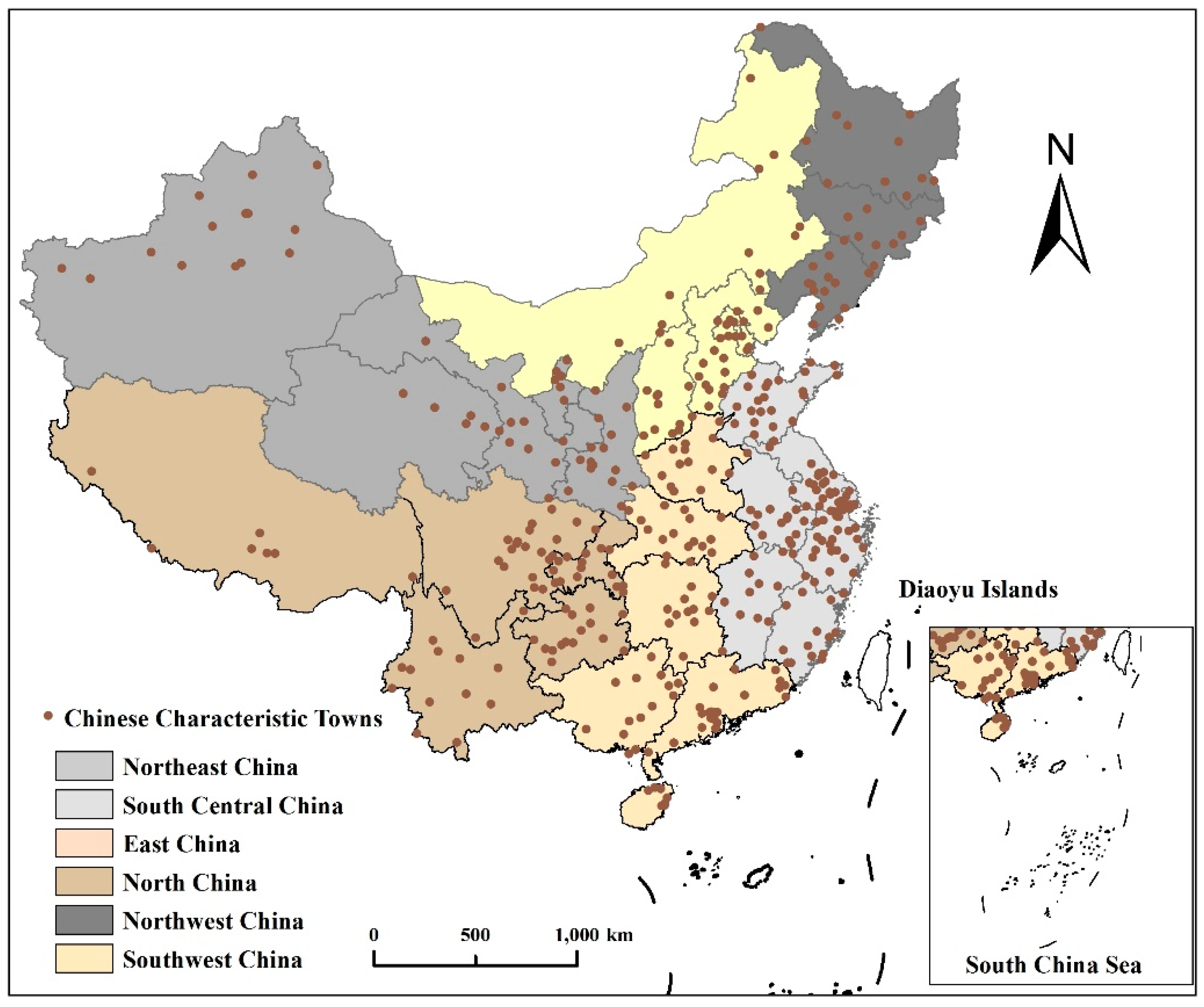
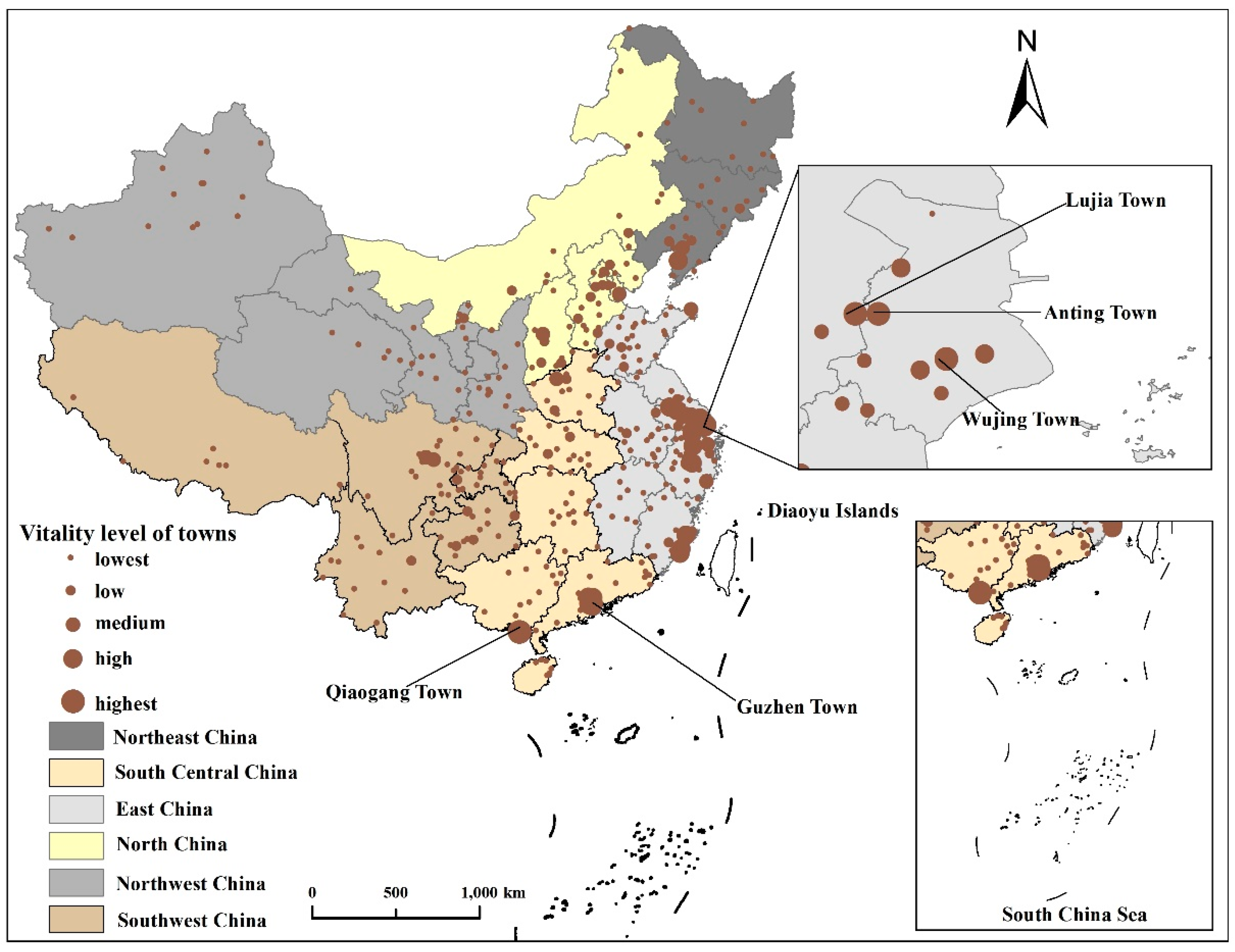
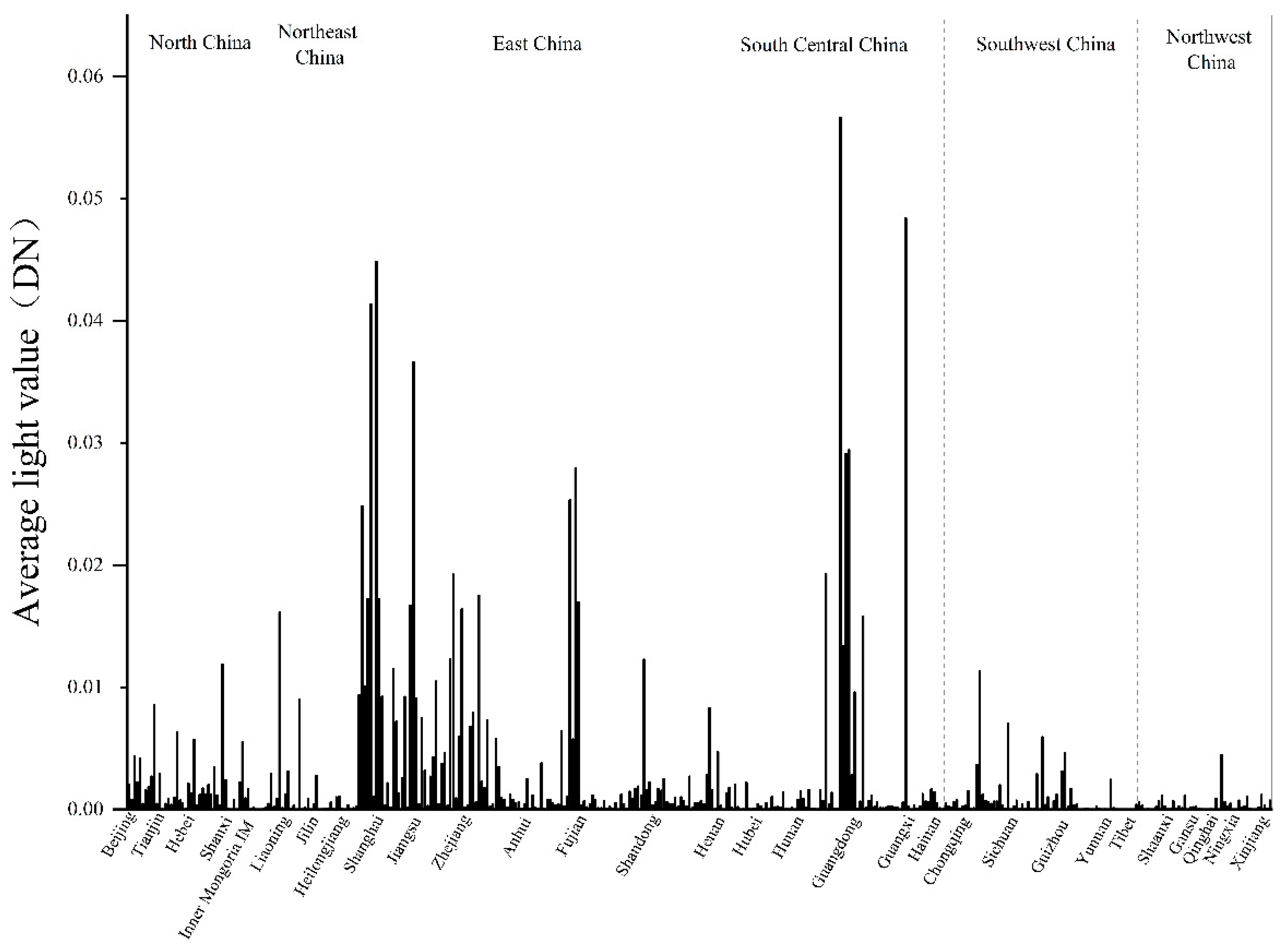
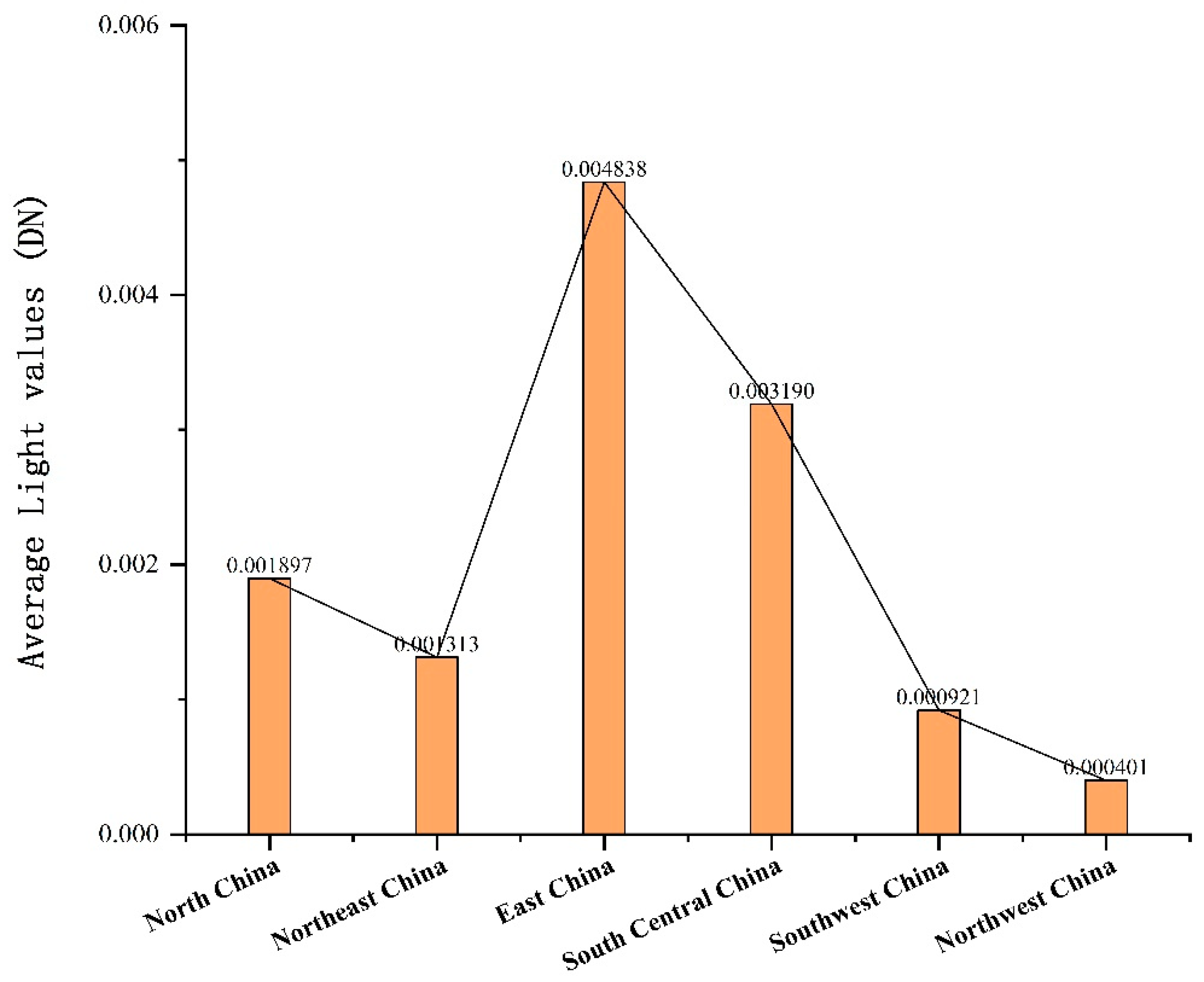
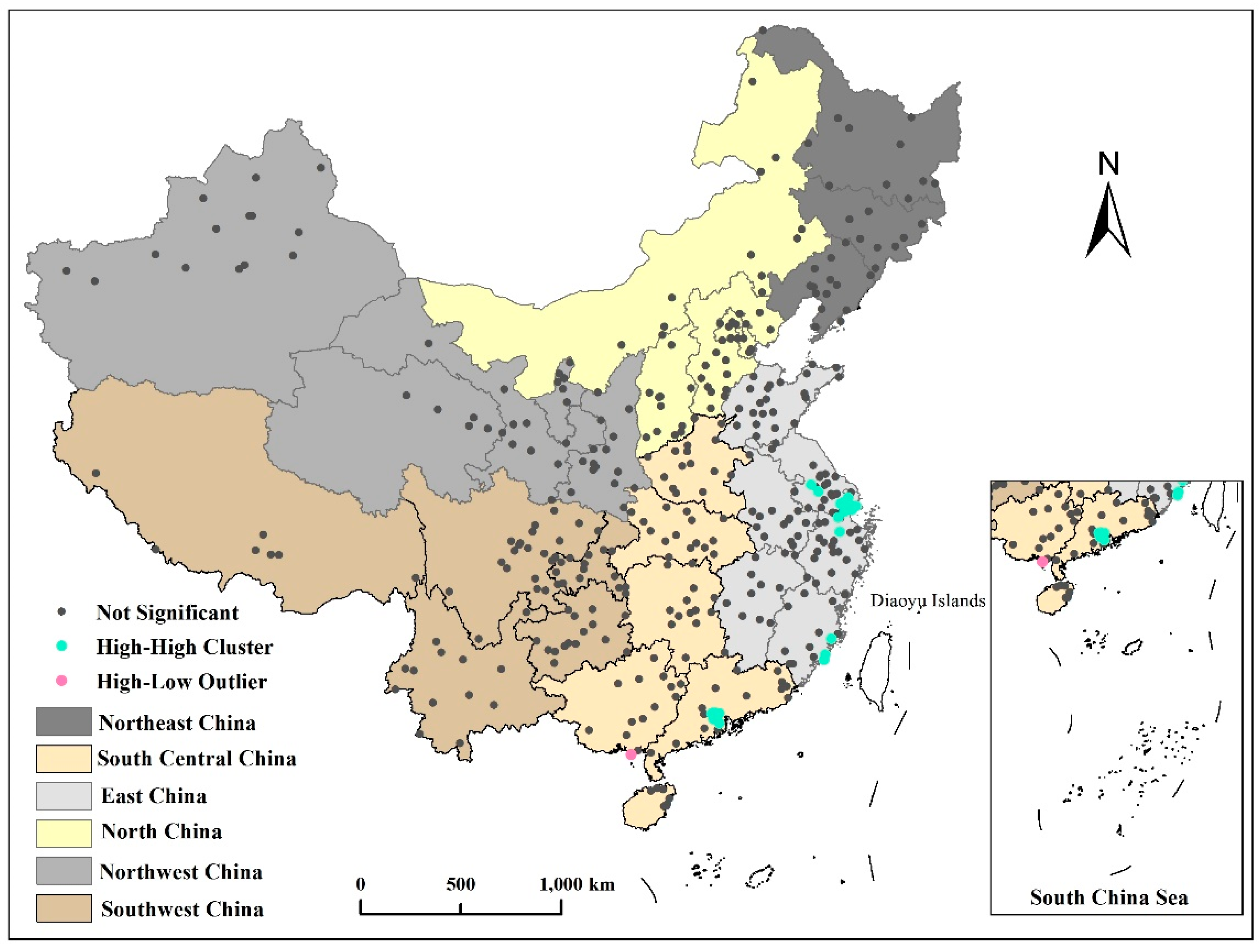
| Date | Data | Source | Details | Purpose |
|---|---|---|---|---|
| 2018 | Luojia1-01 nighttime light data | High-resolution Earth Observation System Hubei Data and Application Center (http://59.175.109.173:8888/index.html) accessed on 10 September 2021 | Total of 402 images, Raster data | Light extraction |
| 2018 | Administrative division data | Water Meridian Micro Chart (http://www.rivermap.cn) accessed on 10 September 2021 | Vector data | Map of study area |
| 2018 | Statistical Data | Statistical Yearbook Sharing Platform (https://www.yearbookchina.com) accessed on 10 September 2021 | Township articles | To acquire statistics |
| Categories | Number of Towns | Average DN Range | Vitality Level |
|---|---|---|---|
| 1 | 312 | 0.000002–0.001912 | lowest |
| 2 | 48 | 0.002023–0.06446 | low |
| 3 | 22 | 0.006819–0.013408 | medium |
| 4 | 15 | 0.015813–0.029433 | high |
| 5 | 5 | 0.036620–0.056652 | highest |
| Rank | Region | Average DN |
|---|---|---|
| 1 | East China | 0.004838 |
| 2 | South-central China | 0.003190 |
| 3 | North China | 0.001897 |
| 4 | Northeast China | 0.001313 |
| 5 | Southwest China | 0.000921 |
| 6 | Northwest China | 0.000401 |
| Index | Value |
|---|---|
| Moran’s I | 0.464942 |
| p-value | 16.269162 |
| Z-value | 0.000000 |
| Towns | |
|---|---|
| HH | Fengjing, Chedun, Zhujiajiao, Xinchang, Wujing, Anting, Luojing, Zhuanghang, Luzhi, Hangji, Lujia, Menghe, Puyuan, Dongpu, Hanjiang, Jinjing, Sanjiangkou, Beijiao, Guzhen, Xiqiao, Shawan, Lecong, Tangxia, and Dayong |
| HL | Qiaogang |
| LH | — |
| LL | — |
Publisher’s Note: MDPI stays neutral with regard to jurisdictional claims in published maps and institutional affiliations. |
© 2022 by the authors. Licensee MDPI, Basel, Switzerland. This article is an open access article distributed under the terms and conditions of the Creative Commons Attribution (CC BY) license (https://creativecommons.org/licenses/by/4.0/).
Share and Cite
Zhang, Y.; Shang, K.; Shi, Z.; Wang, H.; Li, X. Spatial Pattern of the Vitality of Chinese Characteristic Towns: A Perspective from Nighttime Lights. Land 2022, 11, 85. https://doi.org/10.3390/land11010085
Zhang Y, Shang K, Shi Z, Wang H, Li X. Spatial Pattern of the Vitality of Chinese Characteristic Towns: A Perspective from Nighttime Lights. Land. 2022; 11(1):85. https://doi.org/10.3390/land11010085
Chicago/Turabian StyleZhang, Yuqing, Kun Shang, Zhipeng Shi, Hui Wang, and Xueming Li. 2022. "Spatial Pattern of the Vitality of Chinese Characteristic Towns: A Perspective from Nighttime Lights" Land 11, no. 1: 85. https://doi.org/10.3390/land11010085
APA StyleZhang, Y., Shang, K., Shi, Z., Wang, H., & Li, X. (2022). Spatial Pattern of the Vitality of Chinese Characteristic Towns: A Perspective from Nighttime Lights. Land, 11(1), 85. https://doi.org/10.3390/land11010085






